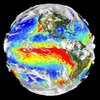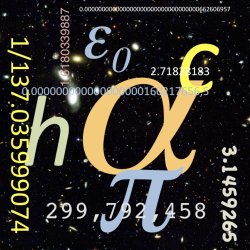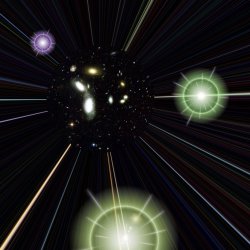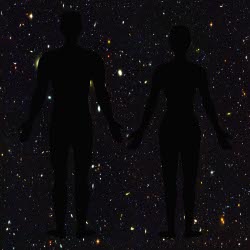-
Viewpoint on 'IONS'
Viewpoint on 'Scientific Literacy'
- Proudly sponsored by
-


-
A Brighter Future for LED Displays

The displays of the future will be stretchable, twistable, deformable into any shape, and, perhaps more importantly, durable, efficient, and cheap. This is the promise of a new approach for manufacturing inorganic light emitting devices (ILEDs).
-
Journey to the Center of the Earth

What happens when we put an electric insulator, such as iron oxide, under pressure and temperature conditions as extreme as those of the Earth’s interior?
-
Checking the Weather of Alien Planets

Which planets in the universe are habitable? Check the weather! It is now possible to know if extra-solar planets have earth-like weather by analyzing the signature the weather leaves in the light scattered by these planets.
The Number of Life
1/137… give or take: the value of the fine-structure constant. Our Universe, our life and everything we know depend on this number. What would the consequences be, if this were to change?
Constants of Nature. Constants of Nature have long fascinated scientists and philosophers alike. What is the reason behind their numerical values? The speed of light (which physicists familiarly call c) is 299 792 458 meters per second, the charge of the electron (e) is 0.000 000 000 000 000 000 160 217 656 5 coulombs, the Planck constant (h) is 0.000 000 000 000 000 000 000 000 000 000 000 662 606 957 Joules times seconds. Certainly, the logic behind these numbers is not what strikes us at first glance. In fact, generations of great scientists have racked their brains looking for any indications of regularity, for any signs of an underlying logic, for any evidence of a set of principles from which these numbers could have been derived. Unfortunately, all efforts have, to date, been unfruitful.
The fine-structure constant α quantifies how electrically charged particles interact. For example, it governs how protons and electrons get together to form atoms. More in detail, α combines in a pure number some of the most fundamental constants of Nature, namely the charge of the electron (e), the speed of light in vacuum (c) and the Plank constant (h).

A bubble in the Multiverse. In the hypothetical Multiverse, Universes with different sets of physical constants may exist next to each other. In all likelihood, only a few of them would present the conditions needed for life to develop and thrive.
Physicists and philosophers alike have been fascinated with the reason why α holds precisely its magic value: not too big, not too small: just right. A lot of effort has been focused on trying to establish the value of α from first principles. As Nobel Laureate Max Born once wrote, "the fact that alpha has just its value 1/137 is certainly no chance but itself a law of nature. It is clear that the explanation of this number must be the central problem of natural philosophy." Be that as it may, the actual value of α remains unexplained. No one has been able to derive the value of α from the fundamental laws underlying the structure of the Universe.

A trillion monkeys. Even though life is obviously not impossible — after all we do exist —, it is certainly highly improbable in a Universe picked at random from the Multiverse. We can draw inspiration from Luis Borges and perform an imaginary experiment. Take a trillion monkeys and let each of them create a Universe with a random set of physical constants of their choice every single day. How long would it take for them to create a Universe sufficiently similar to ours, in which we could comfortably live? About a trillion years, maybe? That’s a pretty a long time — about 50 times longer than the current age of the Universe. However, it is still far too short. If we believe the current form of string theory, it would take our monkeys the literally cosmic time of almost 10500 years. Some scientists have started looking into other possibilities. Could it be that c, e, h, α and all their relatives were not that constant after all? Could it be that their combination of values is just one possibility more amongst a plethora of other possibilities?
When Webb went back to Australia after his sabbatical, he started trying to figure out how he could use the light coming from quasars billions of light years away to make much more precise measurements of α than anyone had done before. Quasars are the most distant astronomical objects ever discovered, laying at the boundaries of the known Universe, about 15 billion light years away from us. Their light reaches us after traveling literally astronomical distances and collecting information about the matter it encounters. As a matter of fact, not all light reaches us, as the atoms found along the way absorb some specific colors. These absorption lines constitute an actual fingerprint of these atoms’ properties and can be analyzed to find out the exact value of α in these distant regions. "We started looking for a way to analyze these data and put an upper bound on the variability of α," Webb remembers, "but it turned out that we could clearly see that α had a value smaller than the one on Earth." They therefore concluded that α increases over time [1].

The anthropic principle. Consider now the probability that our Universe — the one we inhabit — has a set of constants very similar to the ones we observe. Take a moment to ponder this over. This is not just a probability, but indeed a certainty. In fact, were it not so, we would not exist. This is the essence of the anthropic principle: we observe things as they are because, if they were any different, we would not be here to observe them.
Extraordinary claims require extraordinary evidence — as Webb well knows. "When you have got something like this, it obviously needs some independent confirmation before it gets accepted." New information to corroborate or disprove Webb’s analysis might come from radioastronomical observations, which might add some new, completely independent data. Even earthly measurements of α might provide some further insights; in fact, since the Earth is moving through the Universe it might be possible that α might slowly vary over time [2].
Were the spatial variation of α to be confirmed, "the consequences would be dramatic," predicts Webb, "since most physical equations assume constants. If α continues to vary the further away we go, it might never reach an asymptotical value. Maybe this can be an argument in favor of the weak anthropic principle and an explanation why the constants of our Universe are so finely tuned to our needs."
[1] J. K. Webb et al., Search for Time Variation of the Fine Structure Constant, Phys. Rev. Lett. 82, 884-887 (1999).
[2] J. C. Berengut & V. V. Flambaum, Manifestations of a spatial variation of fundamental constants on atomic clocks, Oklo, meteorites, and cosmological phenomena, arXiv 1008.3957 (2010).
Giovanni Volpe
2011 © Optics & Photonics Focus
GV is currently working as a postdoctoral researcher in optics, statistical physics and soft matter at the Max Planck Institute in Stuttgart (Germany).

J. K. Webb, J. A. King, M. T. Murphy, V.V. Flambaum, R. F. Carswell & M. B. Bainbridge, Indications of a Spatial Variation of the Fine Structure Constant, Physical Review Letters (2011) 107, 191101 (link).